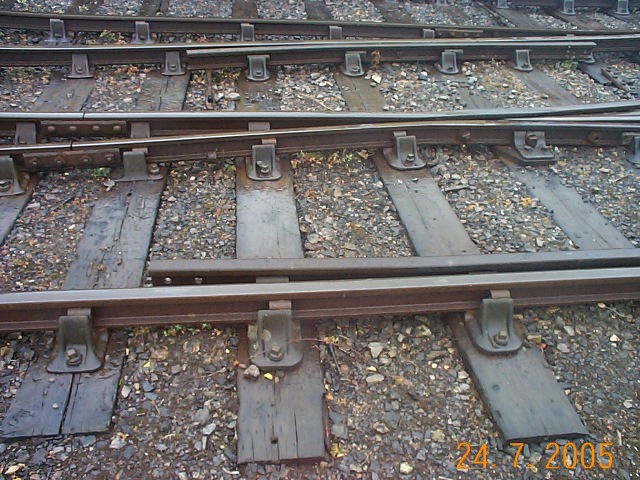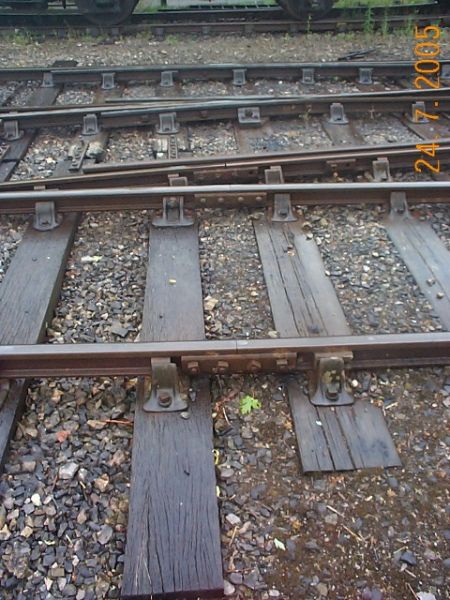Templot Club Archive 2007-2020
|
|||
| author | remove search highlighting | ||
|---|---|---|---|
|
posted: 19 May 2012 20:47 from: Paul Boyd
click the date to link to this post click member name to view archived images |
I think I've just discovered that the check rails in many of my plans may be wrong! It seems that BR(W) placed check rails in a slightly different position to the GWR. Taking a 1:8 crossing as an example, David Smith's book, Table 3 shows that there should be a 14ft check rail extending over five timbers from 1C to 5C (X2 to X6 in Templot terms). This appears to match photos of 1930s track. In his drawing of a B8 turnout on page 36 he shows that the same check rail extends from the L1 chairs to 4C (X1 to X5). Although the title of the book suggests it relates specifically to GWR practise, that drawing is dated 1962. Going to the Scalefour Societies resources here and opening document 1736 would appear to show that a 1:8 crossing should have a 13'6" check rail (drawing dated Apr 1948) but that this extends to the 4C timber, not the 5C as in David Smith's Table 3 but matching his drawing of a B8, whereas document 2999 (Feb 1948) shows that it has a 14' check rail although the position isn't shown. So, two questions! For, say, early 1960s BR(W), should the check rail be 14' or 13'6"? I suspect the former. Given that by 1948 the check rail seems to have moved back by one timber towards the toe, was this a BR thing or did that change take place sometime before that? Or have I missed something completely? (3rd question!) Cheers |
||
|
posted: 19 May 2012 22:45 from: Phil O
click the date to link to this post click member name to view archived images |
Hi Paul I wish you had asked this question yesterday or earlier as I was on the ESR today measuring turnout timber centres and could have run the rule over the check lumps, however Wally of this parish may have some photo's, if he has not replied by tomorrow lunchtime I will ask him to have a look through his archive. All our original turnouts are secondhand pre 2nd world war, varying between 1 in 31/2 and 1 in 11. Cheers Phil. PS. If we have someone on site I will ask them to have a quick measure but it will be sometime. |
||
|
posted: 19 May 2012 23:53 from: wally click the date to link to this post click member name to view archived images |
I have just picked this up and have not looked at any photos but the common thread running through the ex G W stock at Canmore is that then checks are secured by a CENTRAL bolt passing through a spacer block therefore the rail extends an equal number of timbers and CC's each side of the bolt. I will try to find pictures but this may not be untill later in the week. Wally |
||
|
posted: 20 May 2012 11:11 from: wally click the date to link to this post click member name to view archived images |
Having had a few moments this morning here are a couple of photos to add to the confusion. This installation is in the middle of a lot of plain track relaid 1949/1950 and will probably reflect the later thinking. 2374_200548_520000000.jpg  This shows a pair of checks which only span 4 timbers and have a central locating bolt (only visible on the far rail and just out of shot on the near). 2374_200553_050000000.jpg  Here we have a pair which spans 5 timbers with an offset retaining bolt and block and shows better the end on scarfing of two short timbers to form a longer one which was the subject of a previous discussion . This formation was made of second hand OO (97.5 lbs) rail as can be seen from the fshplate bolt holes in the ends of the checks! I suspect that a little bit of local adjustment may have taken place during the installation, but Mr Cook does state that the G W 14ft standard was changed to 13' 6" by the Western region so either could be acceptable depending on the period modelled. Sorry it is not a deffinitive answer, but possibly, it proves that on the ground whatever you do could be right. Wally. P S if anyone is worried about the state of the timbers these are survey shots taken before we relaid the complex. |
||
|
posted: 20 May 2012 11:55 from: Nigel Brown click the date to link to this post click member name to view archived images |
Don't have David Smith's book to hand the moment, but from reading through it in the past I formed the firm impression that the check rail on say a straight 1:7 would be fixed to 4 sleepers, not 5. And that's what I've done consistantly on my layout. Actual length of the rail may be something different. | ||
| Last edited on posted: 20 May 2012 12:04 by Nigel Brown |
|||
|
posted: 20 May 2012 11:57 from: Paul Boyd
click the date to link to this post click member name to view archived images |
Hi Wally Thanks for the info - all adds to the confusion! I didn't know there were any bolts through the check rail, either! but Mr Cook does state that the G W 14ft standard was changed to 13' 6" by the Western regionCould you please elaborate on that reference? I don't know who Mr Cook is, but I get the feeling I ought to Cheers |
||
|
20 May 2012 12:04 from: Paul Boyd
click the date to link to this post click member name to view archived images |
Hi NigelDon't have David Smith's book to hand the moment, but from reading through it in the past I formed the firm impression that the check rail on say a 1:7 would be fixed to 4 sleepers, not 5. And that's what I've done consistantly on my layout.Yes - a 1:7 would span four timbers, but a 1:8 spans five. The question is which five for BR(W) and what length? (although it seems the length is 13'6" in BR(W) times) |
||
| Last edited on 20 May 2012 12:05 by Paul Boyd |
|||
|
posted: 20 May 2012 12:55 from: wally click the date to link to this post click member name to view archived images |
Paul, Sorry for Cook read Smith, my mistake. With regard to the position of the check ral the flare at the divergence end should be approximately opposite the flare on the wing rail. From a purely practical and cynical P W mans point of view the finer points of the length of the full rail are not critical as long as it stops the wheels going the wrong way when passing over the crossing. How's that for a bit of heresy on a forum such as this? Wally |
||
|
posted: 20 May 2012 14:22 from: Paul Boyd
click the date to link to this post click member name to view archived images |
Hi Wally Ah yes - I've just found the reference in David Smith's book that you refer to - it's on page 31, and says that from 1956 the 14' guard was moved one timber space towards the switches, and that from 1957 the length was reduced to 13'6" to fit timbering better. I've also just noticed that the Paddington drawings I got from the Scalefour Society website, specifically R1736 dated April 1948, has a poorly reproduced "Amended 1957" in the bottom right - at least, I think it says 1957. From a purely practical and cynical P W mans point of view the finer points of the length of the full rail are not critical as long as it stops the wheels going the wrong way when passing over the crossing.I just want it to look nice Cheers |
||
|
posted: 20 May 2012 15:14 from: Martin Wynne
click the date to link to this post click member name to view archived images |
Paul Boyd wrote:specifically R1736 dated April 1948, has a poorly reproduced "Amended 1957" in the bottom right - at least, I think it says 1957.Hi Paul, My copies are a bit clearer than the Scalefour Soc. scans. R.1736/April 1948 says at bottom right: Amended 1957 ditto Aug. 1962 The 5 is a bit smudged, but it is the only figure which makes sense between 1948 and 1962. regards, Martin. |
||
| Please read this important note about copyright: Unless stated otherwise, all the files submitted to this web site are copyright and the property of the respective contributor. You are welcome to use them for your own personal non-commercial purposes, and in your messages on this web site. If you want to publish any of this material elsewhere or use it commercially, you must first obtain the owner's permission to do so. |